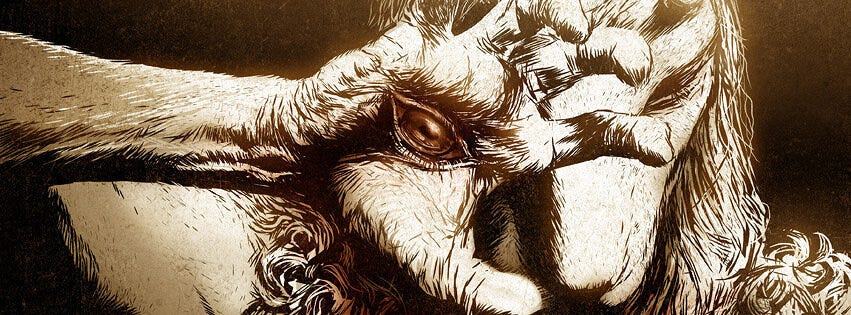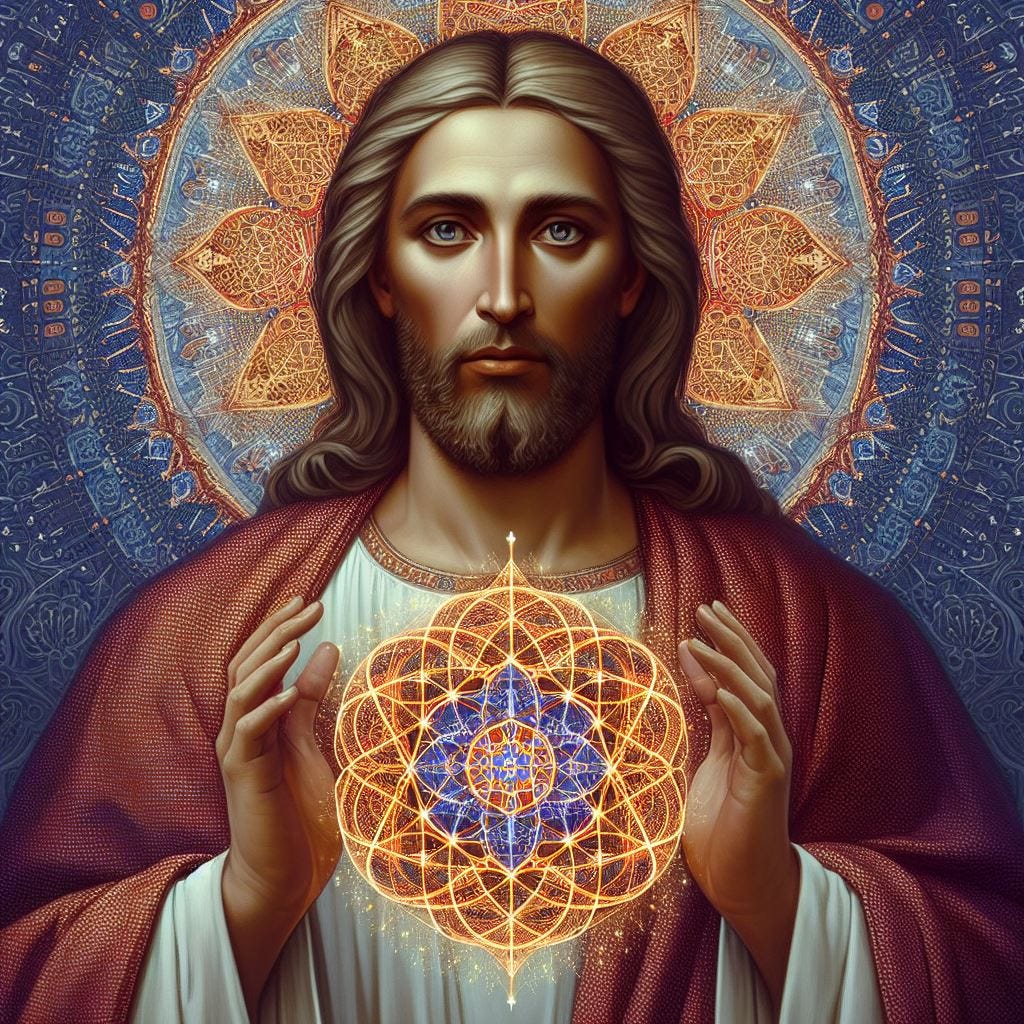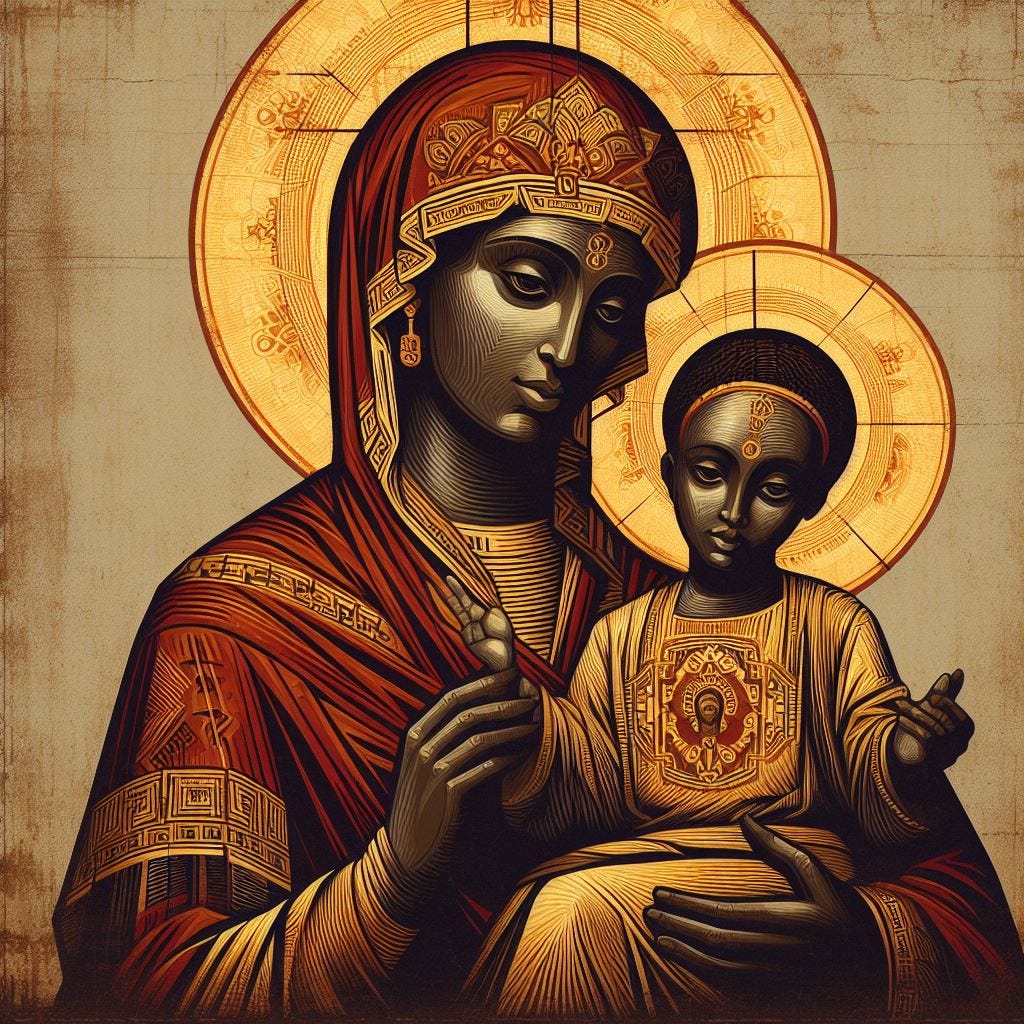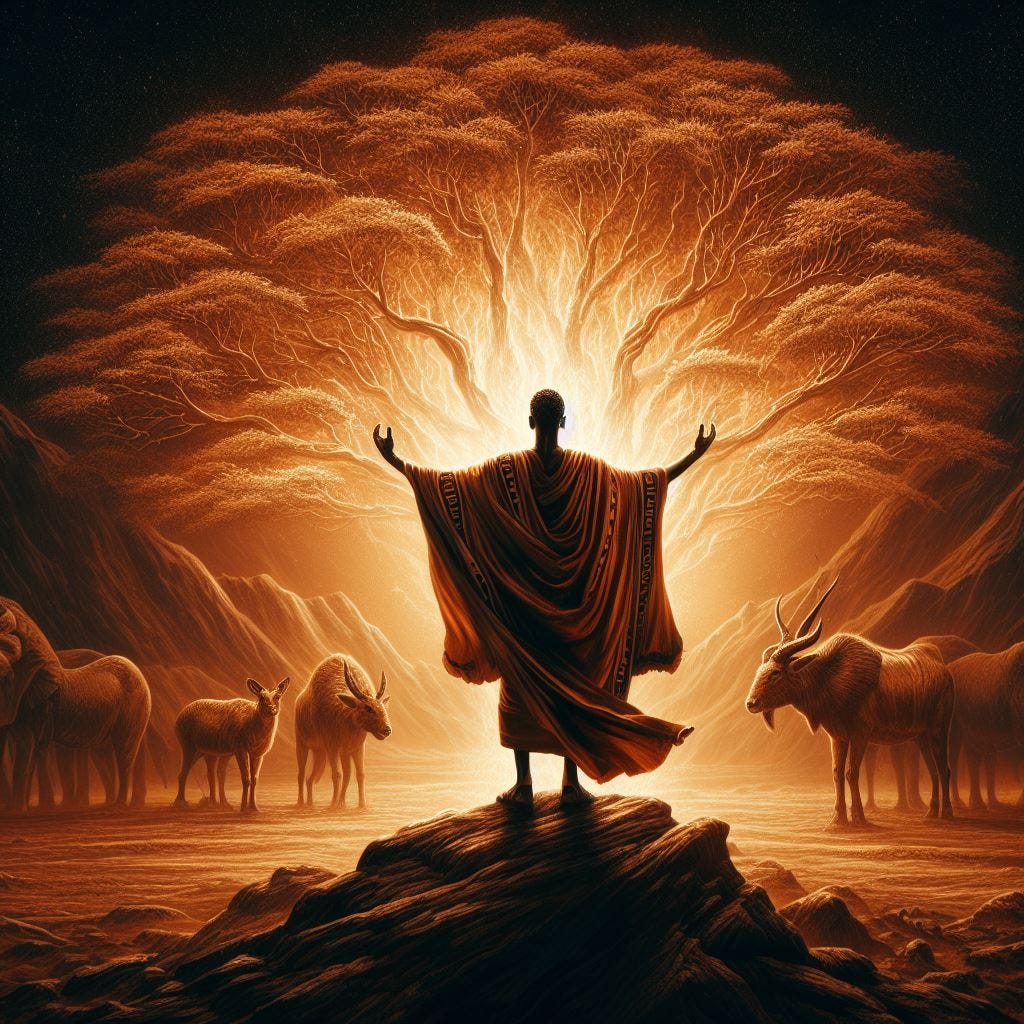Casting Crowns
A Polytheist Theology of Jesus
Hail Mary
What follows is the fruit of a long and somewhat painful process of speculation. It is necessarily incomplete and subject to all sorts of revisions in the future. This is more like a Platonic “likely story” than it is a final account of things. Indeed, I don’t think there is a final account of things. The One transcends Being, therefore there must always be discourse. To go straight to the point, Jesus is a sore spot for any formerly Christian Platonist. He was never really elaborated upon in detail by the early Neoplatonists, except maybe by Porphyry. Now, many polytheists, Platonist or not, take all sorts of stances. There are even “Christo-pagans” who worship other Gods along with Jesus, considered as a God among others. I’m not sure I fit into this category, insofar as I haven’t really prayed to Jesus in a few months, except maybe when blessing my food in the name of the Trinity. But he is a sore spot for me, lingering in the background. I can no longer really see him in the popular pictures and I barely see him in the official orthodox icons. He did promise to be with me even if I abandoned him, which was prophetic in hindsight. So, in appreciation of both Him and His Mother to whom my primary devotion currently belongs, I have desired to discover and articulate his proper prerogative (timē in Greek)[1]. This represents another attempt of mine, first inspired by this attempt. But, to properly begin, we have to articulate the context in which this timē emerges, because it presupposes worlds already existing and in motion. To be platonic about it, Jesus is constituting a plane of being posterior to many others. In whatever ways he is ultimate according to that arche, we still have to understand the other archai. All “scripture” is here treated as “myth”, which explicates being as established by divine beings. In this case, we have to see the arche of Moses, and the arche of the so-called “deceiver”, in order to explicate the arche of Jesus.
I
In a previous post, I mentioned that to consider the Christian Scriptures as myth, I would have to consider the Patriarchs, Prophets, Kings, and Judges as divine souls of some kind, whether Daimons, Heroes Daimonic Gods, or as I’m beginning to entertain, Hypercosmic Psychic Gods. This applies to Moses in ways I didn’t expect. Moses leads his people out of slavery and into the wilderness and to the Mountain. He never steps foot on the Promised Land. He spends the majority of his life in the wilderness. I see Moses as a pre-eminent divine soul, who leads ordinary souls from the slavery of embodiment into the “wilderness” of psychic wandering. The wilderness, death, and afterlife are not uncorrelated.
Moses beholds the Jewish Cosmic Paradigm in the Burning Bush. The face of the demiurge with which he “sees” the world is in fact the Asherah, the paradigm that is the unarticulated glorious temple, whose fruit they (the “heno-fleshed” single-multiple sovereign demiurge) eat, and whose “punishment” is the farming of the fruit of logoi in fertile matter-soil as well as the painful birth of the souls that will incorporate such fruit, a secondary repetition of their story in ours. Adam-Kadmon speaks to Moses, and what Moses sees in the burning arboreal form is the message he heard: Build the living temple. This is the handing over of Moses’ timē. He is to contribute to world forming. But how?
Moses’ work is fundamentally liberatory. He leads souls out of the “Egyptian” slavery of embodiment, of the building of transient things. Insofar as the underworld is the hidden sky, this movement into the wilderness is an ascent, culminating in “Sinai”, where Moses himself is at his monadic summit, his divinity made manifest. He and many others meet the Angel in the pillar of fire, the pillar being the veiled symbol of the paradigm itself, and they “feast”, a communal giving and return of themselves. But Moses goes further still, his transcendence over ordinary souls manifests in his reception of the divine word itself, the articulation of the Logos Arch-Angel. This transcendence is seen in the inability of the people to even await his return. They cannot bear the “imageless” word and its invisible brightness, its visual silence. They form their own image, their limited reception of the theophany, in the form of a Bull, a fitting image of their Baal (translated as “Lord”), but insofar as it is an image, a sign somewhat cut off from the signified, they are still within the Jewish Lord of eidola (Images). The Greek Lord of Eidola, according to the Platonists, is Hades[2]. Indeed, Hades (as a personified place) plays a role in Christian theology. However, given the (Hellenistic) Jewish centre of Early Christianity, we should perhaps see Hades here as syncretized with another deity-place, perhaps Sheol, or better still, for me, as the Serpent who does tempt Eve with subtle words. “Hades” is here as perhaps indicating the kind of deity this is, rather than the God qua himself being Hades. To be very clear, the God (and any God) is not evil. However, the incommensurability of different timē can be represented as conflict, for “Gods are not Themselves in conflict with one another; instead, the conflict in the myth expresses the challenge for us in harmonizing these gifts of theirs in ourselves.”[3]
This “image-making” represents the beginning of the soul’s descent. Moses is an ideal the souls are only ever approximating, especially with the never-ending production of images, the “imaginal” faculty of Souls. It is very ironic that the faculty of imagination, which many more forward-thinking Christians see as essential to any Christian future (and I agree with this) is the activity of Hades, and a participation in his (or an analogous God’s) activity. Jesus himself assumes something of this activity, insofar as he is the “image” of his God. The “Israelites”, who are the souls here, having demonstrated their inability to ascend further, now begin their descent into the world of bodies once more, failing to reach the ideal promised land, they will have to help form an image of it beginning with the formation of psychic structures, starting with the linguistic, that is, “laws”, and a corresponding imaginal analogue in the “tent”. This will guide their descent and taming of the “foreign country” of embodiment. In a sense, they are returning to Egypt, but not as slaves. This is perhaps an extreme example of the idea that:
“The matter upon which the demiurge works is the other Gods themselves, not as co-emergent with the demiurge, not, for example, as the other Gods in the Hellenic pantheon are in relation to Zeus, but in their radical refusal of relation. Even the deities who are co-emergent with, e.g., Zeus, possess nevertheless their pre-existent autonomy in respect of which they too are “matter” in relation to the demiurge’s formative activity. Indeed, even Zeus himself is matter to himself, insofar as he himself, as a henad, trancends his function as demiurge.”[4]
Applied here, the idea is that this is the perspective of demiurgic activity, hence there is an apparent conflict with the autonomy of each God. However, it is “a process in itself never fully completed and rife with possibilities for the reconstitution of incommensurable differences within the momentarily unified field”[5]. This can be seen in the way the Israelites worship many other Gods more often than not, a fact that has led to so many re-articulations of the polity, which we can see as the re-articulation of its psychic structure. Indeed, the Mosaic myth can be seen as a re-articulation itself[6]. The central Jewish (cosmo)polities in which Jesus makes his appearance are the results of such re-articulations.
II

The myths surrounding Jesus are many and sometimes incommensurate. For me, the Johannine Jesus is the most suited to my purposes, but Matthew’s Jesus is the Jesus I have read of the most. Mark and Luke, however, retain a presence in my imagination. Jesus’ Nativity seems to me to be the more complex articulation of the Johannine claim that “the Logos became flesh and pitched a tent among us, and we saw his glory, glory as of the Father’s only one, full of grace and truth.” (John 1:14)[7]. Mary parallels Moses in being directly brought the God’s word, and receiving it into herself. But it is different this time, insofar as what is received is the image of that God. What we see here is Mary in the “divine series” (or what we may call the “divine metaphysical genealogy”) of the Jewish Logos Arch-angel[8], a God[9] in his own right, and from whom Jesus is also to be regarded in that divine series. We can also glimpse something about this Arch-angel’s series by considering Hermes:
“Logos can mean simply ‘word’, but in Platonists has the more complex sense of a formula, i.e., an expression of the constituents of a compound. Logoi can also refer, in a usage borrowed from the Stoics, to the specific formative principles of the parts of a complex being that are subordinate to the overall functional telos, e.g., there is a logos for hair, but not a "form" (eidos), because it merely fulfills one of the requirements of the eidos of a given species of animal, or of Animal in general.
The soul is the logos of intelligibles because it exists to think them through, as it were, in space and time. And language in general is "angelic" relative to divine intelligences. Within many pantheons, moreover, we could perhaps expect to find deities in a relationship similar to that between Zeus and Hermes, that is, a demiurgic intellective God and a God specifically charged with translating that God’s formative will with respect to the cosmos into operative formulae; Re and Thoth, e.g., are in this sort of relationship in the Book of the Celestial Cow. An interesting question, which must remain open for now, is whether, applying here the structure of interpretation Proclus applied to the ‘lawgiver’ who fashions names in the Cratylus, we might thus regard Hermes as the ultimate ‘author’ of at least the divine core of the Greek language.”[10]
Applying this here, we might say that there is a series that runs from the “Father” to the Logos-God through Moses and to Mary and Jesus. This is an “anhomoiomerous” divine series, where “productions from a God are heteronymous, like Dionysos from Zeus.”[11].
Jesus himself takes on the path of Israel, crossing “waters” and entering the wilderness. This is his “initiation” that will pattern the initiation of his followers. He leaves the body into the wilderness of souls, where he refuses the images, holding fast to Moses’ semantic ideality through the support of his laws, receiving at the end communion with the other Angeloi. We see here the first glimpse of Jesus’ activity. He bridges the gap between the sign and the signified. He refuses the phantoms, but in doing so, and acknowledging their existence in this way, he gives them life, he “resurrects” them. By refusing the signs cut off from signified, he can “descend without falling”[12]. This is his “tabernacle”. What Jesus governs is the ideal material, or better still, ideal embodiment.
This explains the seeming “instability” and “ethereality” of his own “displaced” materiality[13]. This is a natural development (among many) of the central place of the “human” in Jewish thought, which gives it a privileged place, even to the point of giving the God’s human form more than just “representationary” value in certain instances. By immediately aligning himself with his divine series, where we see entities like Moses and Elijah, he establishes something of that ideality of the human in his factical humanity; while his “face to face” communion with his “Father” establishes him as the “perfect sacrifice” insofar as “To be sacrificed, in the genuine sense, is to be withdrawn from the economy of being another goat, another human, another instance of any universal, and to become the unique individual that is. At this point the theology of sacrifice and that of salvation become indistinguishable.”[14] Compare this to D.B. Hart’s statement that “Easter reveals that divine justice is on the side of the particular, the rejected, the victim we are willing to offer up to the greater good.”[15] Indeed, in John, the “resurrection” seems to be indistinguishable from the resurrection insofar Christ is “raised up” on the Cross. We see, on the cross, where the justice of the world’s politics fails, the inexhaustibility of this individual, revealed as a God. This revelation is only seen in hindsight, in the vision of his “rainbow body” missing from the empty tomb.
This “resurrection” colours the entire sacrifice, insofar as the purely formal logic of sacrifice as salvation requires thickening with the local theology, although the ontological priority is actually in reverse. While in the Mosaic timē, There is a disjoint between the sacrifice and the priest, whom (along with the people) the sacrifice represents – an instance of the Serpent’s eidola sovereignty, sign separated from signified – in Jesus, they coincide once more, at the very edges of Being’s procession. Insofar as the “tomb” is this world of images, Christ’s resurrection is bringing life to this tomb, transcending it, and yet filling it. Many have noted – in good and bad ways, and with the intention of praising or deriding it – that Jesus is very “Dionysian”; but few have noticed the way, because of his manner of activity, the way he is also like Persephone, insofar as he gives life to the Hadeic images.
This is also the import of the idea that it is Jesus, and his followers, who “replace” the Angels and Gods. Insofar as they are parallel, both unities of sign and signified, we can see the ways in which the transition to this plane of being or activity can be seen as a transfer of sovereignty, whether willingly – as we see in the book of revelation where “the Ancient Ones get up from their thrones, fall prostrate, and cast their crowns before the Enthroned One. They never sit back down. They never pick up their crowns. And when we see thrones again, they have new occupants – not the angelic Ancient Ones but human beings who have defied the Dragon”[16] – or where, as we have seen, taken by force. We might say both perspectives concern different classes of entities. Those who cast their crowns willingly are perhaps the higher angels and Gods. Those who have to be fought for it represent the Gods with lower activity, the same Gods the Israelites fought earlier. As usual, the myth here should be interpreted as revealing the constitution of being, not as detailing ethics, even if there is an ethical dimension to each religion (and I would say the first ethical failing is precisely that moral misinterpretation of the character of Gods and their divine “associates”).
This is the “apocalypse”, the revelation of this God and his translation of his Father’s vision to a material key. He invites his people into this ideal materiality, the “ether” of imaginal resurrection, to fulfil the promise to Abraham to be as the Stars, that is, to be co-rulers of the Jewish Cosmos, to be “glorious spirits”, who are very much visible, insofar as looking up, we do not see simply stars as symbols of saints, but as the saints themselves manifest. Christ is not separate from his bread-body, neither are the saints separate from their star-bodies and church-bodies. In “ascending” to the heavens, he returns to the “wilderness”, but now not as a disembodied soul, but as the ideal body, straddling this “hidden heaven” and visible earth, displaced as the dark night sky and clothed in the blue day-sky, like his Mother is clothed with the Sun (Rev. 12:1).
III

The Jewish Man is a Jewish God, and his universality is the basis of Christianity as a “Judaism for Gentiles”. This is perhaps the seed of the way Christianity will be re-integrated into the cosmopolitical and polytheist field, starting with the fractal nature of this cosmogony, in which the Christian sovereignty (as it was eventually constituted as distinct from Judaism) is a “fractal edge” of Judaism itself, the Gentiles “grafted”, as Paul says, into the Jewish body-politic. But like any fractal structure, the fractals at the edge are themselves potentially infinite in depth, and from their perspective, they are the centre of which others are at the Edge. Apply this liberally, to as many traditions as possible, and we have a polycentric structure, where “Each culture has an infinity of "proper names" (of its Gods and ancestors) from which an infinite number of "worlds" with universal potential can be extracted.”[17]
[1] “it is precisely the potential of each to be the first or sovereign principle that is distributed in such an economy; this is the timē, the prerogative, of each God which Zeus, in Hesiod’s Theogony, stabilizes His Olympian regime by recognizing (Theogony 392-6). It is not a question of some narrow role in a division of labor, for if this was all that each God had to offer, if They were so inherently limited, then They would form a whole in any case. No; it is precisely because each God is Themselves the God that Their free choice to enter into such an economy of reciprocal recognition has meaning and force.” - Edward P. Butler, The Way of Being: Polytheism and the Western Knowledge System (Notion Press, 2023). Pg 8.
[2] “For Platonists, Hades is the demiurge of the world of images, that is, this world insofar as this world is taken as a collection of (mere) images of the ideal.” – E.P Butler, in “Endymions_bower | More on Dionysos,” accessed January 22, 2023, https://endymions-bower.dreamwidth.org/21514.html; " Every mortal being seeks to make an impression upon the world in the shape of its will, a copy of itself, and finally passes through the mirror, becoming its own image as the gap between what is willed and what is accomplished vanishes. This is the attraction Plouton exerts — becoming one with the world itself." -E.P. Butler, in Bibliotheca Alexandrina et al., Host of Many: Hades and His Retinue, ed. Terence P. Ward, 2021.
[3] Edward P. Butler, The City of the Gods: A Platonic Polytheist’s Thoughts on the Republic (Notion Press, 2023).
[4] Edward Butler, “The Metaphysics of Polytheism in Proclus” (New School University, 2003), https://henadology.files.wordpress.com/2009/09/dissertation-revised-copy1.doc. Pg 342
[5] Butler. Pg 344
[6] Yonatan Adler, The Origins of Judaism: An Archaeological-Historical Reappraisal, The Origins of Judaism (Yale University Press, 2022), https://doi.org/10.12987/9780300268379.
[7] David Bentley Hart, The New Testament: A Translation (Yale University Press, 2017).
[8] ‘Although angelos, “messenger” or “herald”, is already used by Homer to refer to the birds of augury (Iliad 24.292, 296), the term does not become popular in a theological context until much later, in the era of Hellenistic multiculturalism, and it was probably Iamblichus who first accorded these entities a systematic position in Platonism; e.g. De Mysteriis II. 6, where we even find “archangels”, a term not much used by subsequent Platonists (Proclus uses the term once, in his Cratylus commentary (37), in an unusual context I shall discuss below). Since Iamblichus was Syrian, it is possible that he adopted angeloi into his system at least in part to reflect the usage of Greek-speaking theorists of Semitic religious traditions who felt, for whatever reason, that certain of the semi-divine entities of those traditions were not accurately described as daimons, which was by far the more common term in Greek for an incorporeal entity with a mediate status between Gods and humans. I don’t know enough about those traditions to comment on what might have been the issue; perhaps the tendency to conceive daimons as being souls of some sort. At any rate, angels became a standard, if not much remarked upon, element of Platonic ontology after Iamblichus, the triad of “angels, daimons and heroes” becoming a familiar refrain in later Platonists to refer to the classes of beings immediately superior to mortals.” – E.P. Butler, in “Endymions_bower | Neoplatonic Angelology,” accessed February 12, 2023, https://endymions-bower.dreamwidth.org/25169.html.
[9] “Apparently the unusual term "archangel" is used here to distinguish Hermes, as the God of angels, so to speak, from mere angels, who are, unlike Hermes, beings.” – E.P. Butler, in “Endymions_bower | Neoplatonic Angelology.”
[10] “Endymions_bower | Neoplatonic Angelology.”
[11] “Endymions_bower | February Twitter Archive,” accessed February 24, 2023, https://endymions-bower.dreamwidth.org/36215.html.
[12] “Endymions_bower | February Twitter Archive.”
[13] “The Displaced body of Jesus Christ” by Graham Ward, in John Milbank and Catherine Pickstock, Radical Orthodoxy, Philosophy, 1999.
[14] Edward P Butler, “Gods and Daimons in the Platonic Economy of Sacrifice,” n.d.
[15] David Bentley Hart, The Hidden and the Manifest Essays in Theology and Metaphysics (Wm. B. Eerdmans Publishing Co., 2017).
[16] Peter Leithart, “In Medias Res: Lords of the Universe,” accessed October 28, 2023, https://mailchi.mp/theopolisinstitute/in-medias-res-little-children-1141362?e=8bd795d913.
[17] Petter Hübner, https://substackcdn.com/image/fetch/w_1456,c_limit,f_webp,q_auto:good,fl_progressive:steep/https%3A%2F%2Fsubstack-post-media.s3.amazonaws.com%2Fpublic%2Fimages%2F680b44a0-b84e-4c88-9d56-e387d43e95e9_1060x1113.jpeg.




Oluwaseyi, I am absolutely delighted ti come across your work. This piece weaves and highlights more than I can articulate in a comment. I was particularly struck by your use of the word, imaginal, your intertwining of Jesus and not only Dionysus but especially Persephone. I wonder if you know the work of Peter Kingsley re: Parmenides and Persephone in both “Reality” and “The Dark Places of Wisdom.”
Are you familiar with Margaret Barker's work? She posts a father God El, and national gods ("sons of God") of which one, and the firstborn is YHVH, though in her hypothesis these two were conflated as one being by Deuteronomist revisions. El being the father of all gods. In exile, the Israelites began to resent similarities between themselves and their captors, so any vestige of polytheism began to be expunged, even erasing most of the angelic hierarchies. With the arrival of Christianity, rabbis quickly dissociated themselves from the Book of Enoch, which provided too clear a link between Judaism and the new impulse. Though, obviously, the hierarchies are maintained in the whisper tradition of Kabbalah.